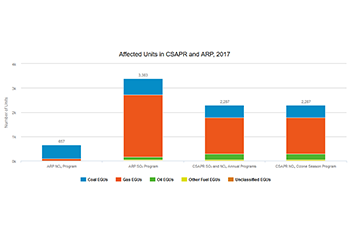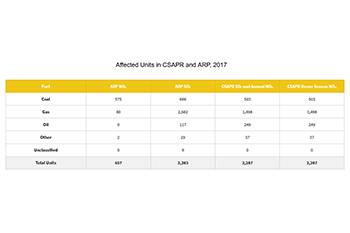Progress Report
Affected Units
Affected Units Figures
Source: EPA, 2019
Last updated: 06/2019
Related Figures


Highlights
Acid Rain Program (ARP)
- In 2017, ARP SO₂ requirements applied to 3,383 fossil fuel-fired combustion units at 1,195 facilities across the country; 657 units at 295 facilities were subject to the ARP NOₓ program.
Cross-State Air Pollution Rule (CSAPR)
- In 2017, there were 2,287 affected EGUs at 712 facilities in the CSAPR SO₂ program. Of those, 1,805 (79 percent) were also covered by ARP.
- In 2017, there were 2,287 affected EGUs at 712 facilities in the CSAPR NOₓ annual program and 2,623 affected EGUs at 837 facilities in the CSAPR NOₓ ozone season program. Of those, 1,805 (79 percent) and 2,124 (81 percent), respectively, were also covered by ARP.
Mercury and Air Toxics (MATS)
- The Mercury and Air Toxics Standards (MATS) set limits on the emissions of hazardous air pollutants from coal- and oil-fired electric utility steam generating units (EGUs) in all 50 states and U.S. territories. MATS is issued under section 112 of the Clean Air Act and requires units to conduct testing and submit emissions data to EPA periodically. EPA is including a summary of the mercury data submitted by affected sources in this report.
- In 2017, 530 units at 235 facilities reported hourly mercury emissions to EPA under MATS.
Background Information
In general, ARP; the CSAPR SO₂, NOₓ annual, and NOₓ ozone season trading programs; apply to large EGUs – boilers, turbines, and combined cycle units – that burn fossil fuel, serve generators with nameplate capacity greater than 25 megawatts, and produce electricity for sale. MATS applies only to coal- and oil-fired steam generating EGUs (i.e., utility boilers). It does not apply to turbines, combined cycle units, or to natural gas-fired utility boilers. These EGUs include a range of unit types, including units that operate year-round to provide baseload power to the electric grid, as well as units that provide power only on peak demand days. The ARP NOₓ program applies to a subset of these units that are older and historically coal-fired.